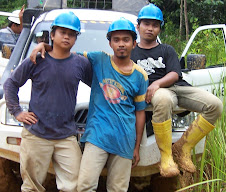Concept of Stratigraphy in Geology and Archaeology
Stratigraphy is based on superimposition. This is a simple concept stating that as layers of soil accumulate, the older deposits become progressively more deeply buried. Therefore each layer in a sequence of soil is younger than the one below it. In reality the situation usually is much more complex than this.
In archaeology we see that cuts (such as pits, ditches, post-holes and cellars) disturb this simple sequence. However, superimposition still works. The pit, etc is younger than (and therefore stratigraphically above) the layers through which it has been cut. Its fill will be younger than the pit cut itself. A layer that covers both the pit fill and the surrounding soil will be younger than both of them. The situation becomes even more complex when a later pit is cut through the first pit fill. Careful excavation is needed to sort out such complex stratigraphy.
In geology, the same concept is valid, as erosion (such as channels, rivers, valleys) disturb a superimposed sequence. The erosion is younger than the layer below it. The fill of this erosion is even younger than the erosion itself. If the erosion and the fill is covered with new layers, these are the youngest in the sequence.
Back to our archaeology example and tell you about other scenarios.
Sometimes we find ourselves digging something that appears to belong to an earlier period than the layer below it. For instance, after a ditch has been dug, material from outside (i.e. stratigraphically earlier) may collapse into it as a large block. It now appears that the ditch contains soil that is actually older than the ditch itself. In reality however, the soil has been moved ('re-deposited') from its original position and this makes it stratigraphically a new deposit. Again careful excavation is needed to identify such re-deposited layers and avoid obtaining erroneous dates from them.
In geology this example could be erosion of older rocks from somewhere else and transported into a new area with f.inst rivers or even an avalanche. These rocks are deposited on existing rocks in their new place, and are therefore superimposed on rocks deposited before, however the transported rocks can be older than the ones they are superimposed on. We say these older rocks are deposited later, however are older than the rocks they are deposited upon.
Disentangling these relationships is part of the challenge and fun of geology and archaeology. Within geology these studies form basic principle for exploration for oil and gas traps, and is referred to as sequence stratigraphy.
Writed by Stig Kristoffersen
Stratigraphy is based on superimposition. This is a simple concept stating that as layers of soil accumulate, the older deposits become progressively more deeply buried. Therefore each layer in a sequence of soil is younger than the one below it. In reality the situation usually is much more complex than this.
In archaeology we see that cuts (such as pits, ditches, post-holes and cellars) disturb this simple sequence. However, superimposition still works. The pit, etc is younger than (and therefore stratigraphically above) the layers through which it has been cut. Its fill will be younger than the pit cut itself. A layer that covers both the pit fill and the surrounding soil will be younger than both of them. The situation becomes even more complex when a later pit is cut through the first pit fill. Careful excavation is needed to sort out such complex stratigraphy.
In geology, the same concept is valid, as erosion (such as channels, rivers, valleys) disturb a superimposed sequence. The erosion is younger than the layer below it. The fill of this erosion is even younger than the erosion itself. If the erosion and the fill is covered with new layers, these are the youngest in the sequence.
Back to our archaeology example and tell you about other scenarios.
Sometimes we find ourselves digging something that appears to belong to an earlier period than the layer below it. For instance, after a ditch has been dug, material from outside (i.e. stratigraphically earlier) may collapse into it as a large block. It now appears that the ditch contains soil that is actually older than the ditch itself. In reality however, the soil has been moved ('re-deposited') from its original position and this makes it stratigraphically a new deposit. Again careful excavation is needed to identify such re-deposited layers and avoid obtaining erroneous dates from them.
In geology this example could be erosion of older rocks from somewhere else and transported into a new area with f.inst rivers or even an avalanche. These rocks are deposited on existing rocks in their new place, and are therefore superimposed on rocks deposited before, however the transported rocks can be older than the ones they are superimposed on. We say these older rocks are deposited later, however are older than the rocks they are deposited upon.
Disentangling these relationships is part of the challenge and fun of geology and archaeology. Within geology these studies form basic principle for exploration for oil and gas traps, and is referred to as sequence stratigraphy.
Writed by Stig Kristoffersen

Tidak ada komentar:
Posting Komentar